check engine AUDI A8 2014 User Guide
[x] Cancel search | Manufacturer: AUDI, Model Year: 2014, Model line: A8, Model: AUDI A8 2014Pages: 314, PDF Size: 78.47 MB
Page 34 of 314
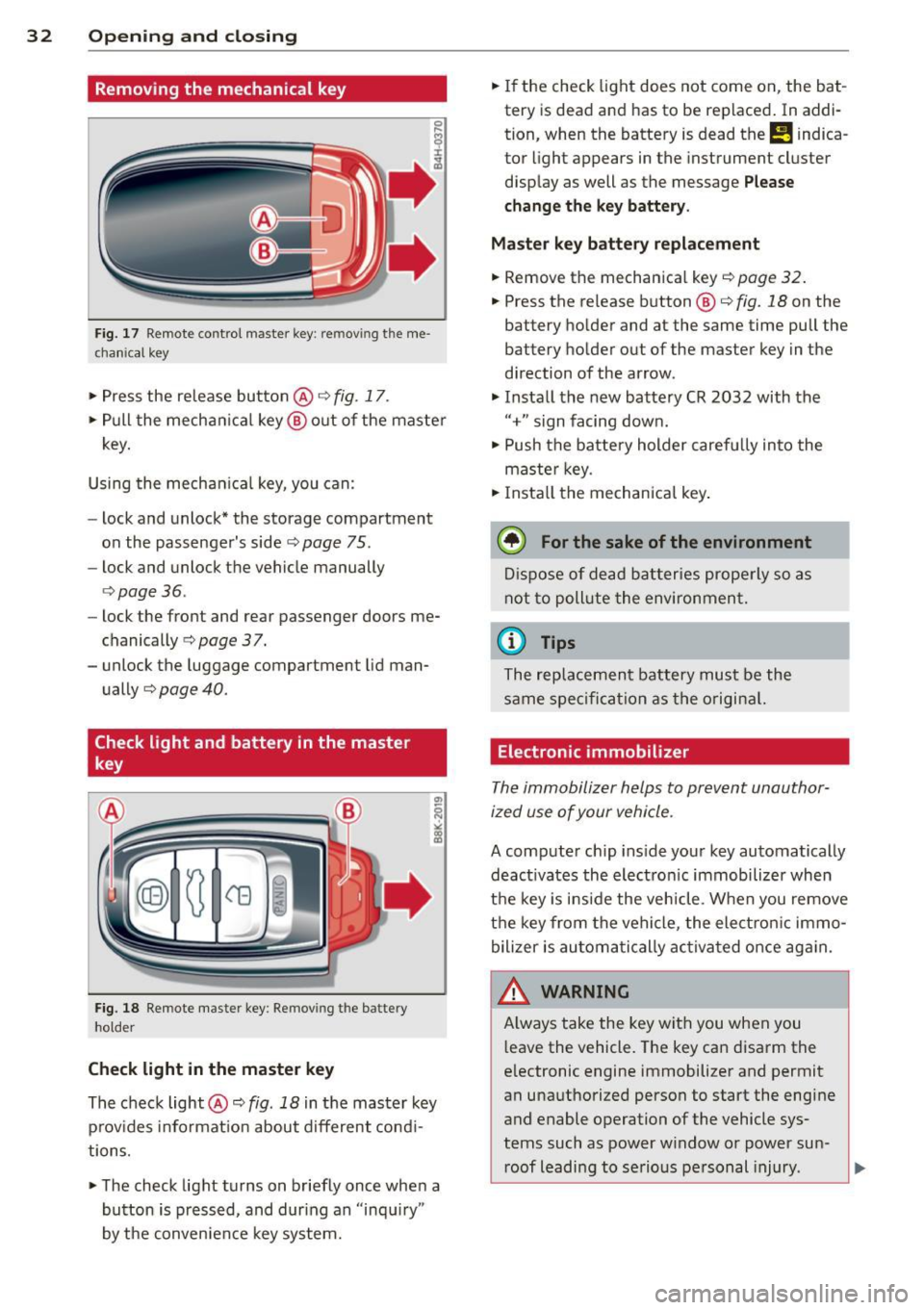
32 Opening and clo sing
Remov ing the mechanical key
Fig. 17 Remote co ntrol master key : re m ov ing the me
c hani cal key
.. Press the release button @c::> fig. 17.
• Pull the mecha nica l key @ out of the master
key.
Using the mechan ica l key, you can:
- lock and unlock* the storage compartment
on the passenger's side c::>
page 75.
-lock and unlock the vehicle manually
<=> page 36.
-lock the front and rear passenger doors me
chanically
c::> page 37.
- unlock the luggage compartment lid man
ually
c::> page 40.
Check light and battery in the master
key
Fig. 18 Remote master key : Remov ing t he batte ry
ho lder
Check light in the master ke y
The check light@c::> fig. 18 in the master key
prov ides informat ion about d ifferent cond i
tions.
• The check light turns on briefly once when a
button is pressed, and dur ing an "inquiry"
by the conven ience key system. •
If the check light does not come on, the bat
tery is dead and has to be replaced . In addi
tion, when the battery is dead
the m indica
tor light appears in the instrument cluster
display as well as the message
Pl ease
c hang e th e ke y b attery .
Ma ster key batter y replacement
• Remove the mechanica l key c::> page 32.
• Press the release button @ c::> fig. 18 on the
battery holder and at the same time pull the
battery holder out of the master key in the
direction of the arrow .
.. Install the new battery CR 2032 with the
"+ " sign facing down .
.. Push the battery holder carefu lly into the
maste r key.
• Insta ll the mechanical key .
@ For the sake of the environment
Dis p ose of dead batteries prope rly so as
not to poll ute the environmen t.
{D Tips
The replacement battery mus t be the
same specification as the o rigina l.
Electronic immobilizer
The immobilizer helps to prevent unauthor
ized use of your vehicle .
A computer chip ins ide your key automatically
deact ivates the elect ron ic immobilizer when
t h e key is ins ide the veh icle . When you remove
the key from the vehicle, the elect ron ic immo
bilizer is au toma tic ally activa ted once aga in.
& WARNING -
A lways take the key w ith you when you
l eave the vehicle. The key can disarm the
e lectronic engine immobilizer and permit
an una uthorized person to start the engine
and enable operation of the vehicle sys
tems such as power w indow o r power sun -
r oof leading to se rious pe rsonal injury.
~
Page 70 of 314
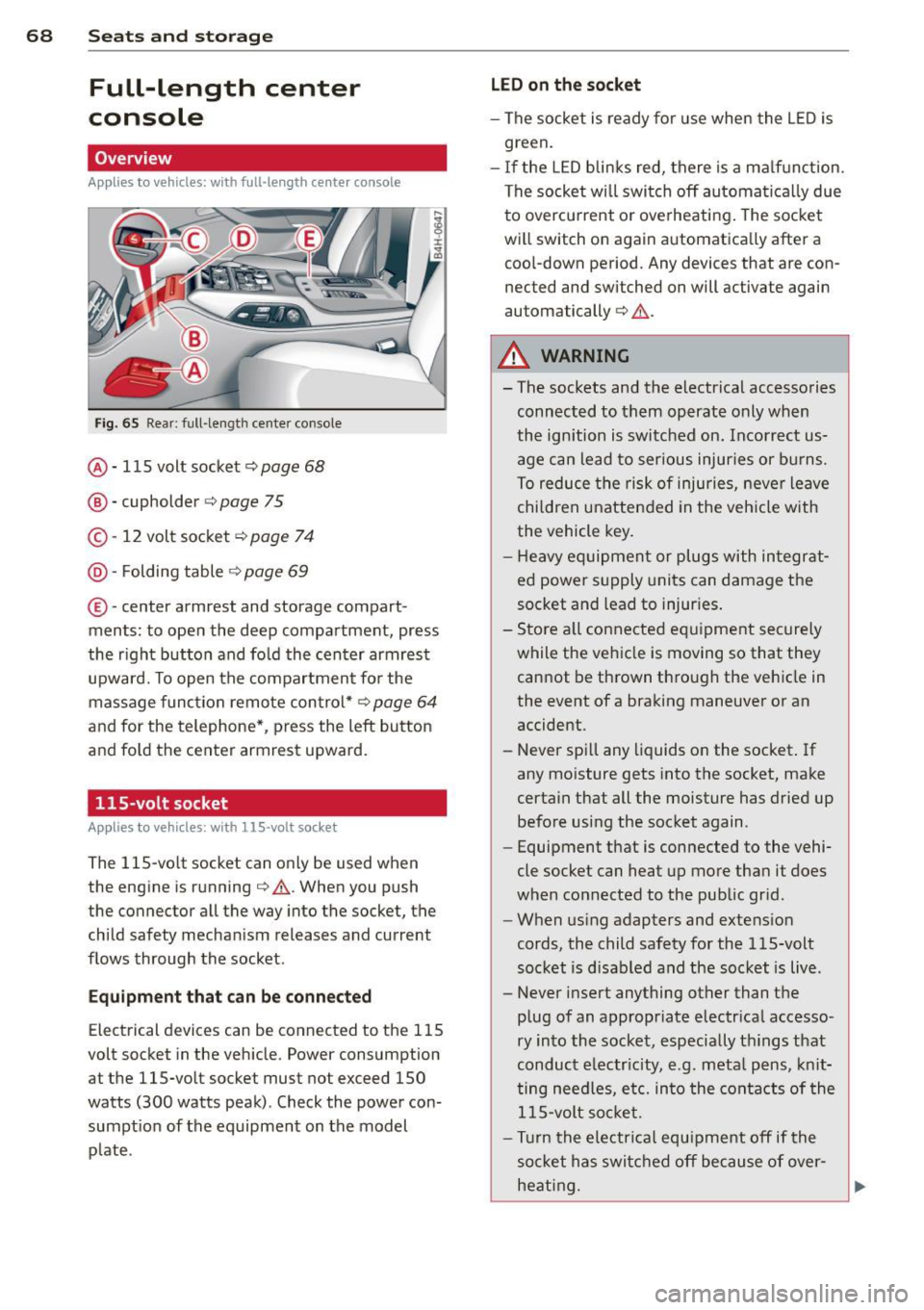
68 Seats and storage
Full-length center
console
Overview
Appl ies to vehicles: with full-len gth ce nter console
Fig. 65 Rear: full -length center console
@ · 115 volt socket ¢ page 68
@ · cupholder <=> page 75
© · 12 volt socket c:> page 7 4
@ · Folding table ¢ page 69
® ·center armrest and storage com part ·
ments: to open the deep compartment, press
the r ight button and fo ld the center armrest
upward. To open the compartment fo r the
massage func tion remote con trol*
c:> page 64
and fo r the telephone* , press the left button
and fo ld the center armrest upward.
115-volt socket
App lies to vehicles: with 115 -vo lt socket
The 115-vo lt socket can only be used when
the engine is running¢
A. When you push
the connector all the way into the socket, the
child safety mechan ism releases and current
flows through the socket .
Equipm ent that can be conn ected
Electrical devices can be connected to the 115
volt socket in the veh icle. Power consumption
at the 115-volt socket must not exceed 150
watts (300 watts peak) . Check the power con·
sumpt ion of the equipment on the model
p late .
LED on th e socket
- The socket is ready for use when the L ED is
green.
- If the LED blin ks red, there is a ma lf u nction.
The socket wi ll swi tch off automa tica lly due
to overcu rrent or overheating. The socke t
will switch on again automatica lly after a
coo l-down period. Any devices that are con
nected and switched on will activate again
automatically
c:> A .
A WARNING
-
- The sockets and the electr ical accessories
connec ted to them operate only when
the ignition is switched on. Incorrect us
age can lead to ser ious injuries or burns.
To reduce the risk of injuries, neve r leave
chi ldren unattended in the veh icle with
the vehicle key .
- H eavy equipment or plugs with in tegrat
ed power s upply units can damage the
socket and lead to injur ies .
- Sto re a ll connected e quipment securely
while the veh icle is moving so that they
cannot be thrown through the veh icle in
the event of a braking maneuver or an
accident.
- Never sp ill any liquids on the socket . If
any mo isture gets into the socket, make
certain that all the moisture has dried up before using the socket again.
- Equipment that is connected to the vehi·
cle socket can heat up more than it does
when connected to the public gr id .
- When us ing adapters and extens ion
cords, the child safety for the 115-volt
socket is d isabled and the socket is live.
- Never insert anything other than the
p lug of an appropriate e lectr ical accesso·
ry in to the socket, especially th ings that
conduct e lectr icity, e.g . meta l pens, kn it
ting needles, etc. in to the cont acts of the
1 15-volt so cket.
- Turn the electrical equ ipment off if the
socket has switc hed off because of over·
heat ing.
Page 79 of 314
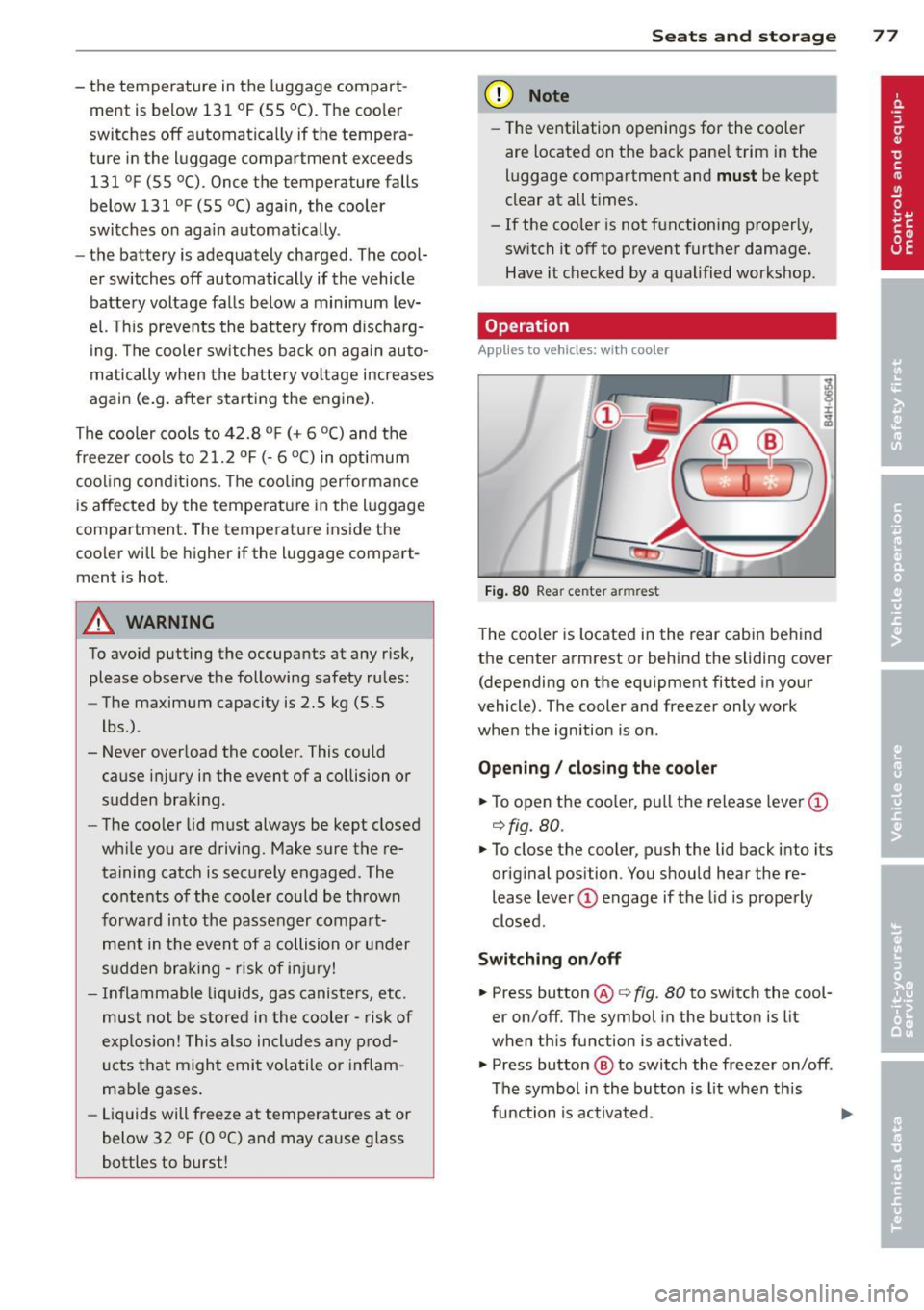
- the temperature in the luggage compart
ment is below 131 °f (55 °C). The cooler
switches off automatically if the tempera
ture in the luggage compartment exceeds 131 °f (55 °C) . Once the temperature falls
below 131 °f (55 °C) again, the cooler
switches on aga in automat ically .
- t he battery is adequately charged . The cool
er switches off automatically if the vehicle
battery voltage falls below a minimum lev
el. This prevents the batte ry from discha rg
i ng . The cooler switches back on again auto
matically when the battery voltage increases
again (e.g . after starting the engine).
The cooler cools to 42.8 °f
(+ 6 °C) and the
freezer cools to 21.2 °f (- 6 °C) in opt imum
cooling cond itions . Th e cooling performance
is affected by the temperature in the luggage
compartment. The temperature inside the
cooler will be higher if the luggage compart ment is hot.
A WARNING
To avoid putting the occupants at any risk, please observe the following safety rules:
- The maximum capacity is 2.5 kg (5.5
lbs.).
- Never overload the cooler. This could cause injury in the event of a collision or
sudden braking.
- The coo ler lid must always be kept closed
while you are driving. Make sure the re
taining catch is securely engaged . The
contents of the coo ler could be thrown
forward into the passenger compart
ment in the event of a collision or under
sudden braking - risk of injury!
- Inflammable liquids, gas canisters, etc.
must not be stored in the cooler -risk of
exp losion! This also includes any prod
ucts that might emit volatile or inflam
mable gases.
- Liquids will freeze at temperatures at or
below 32 °f (0 °C) and may cause glass
bottles to burst!
Seats and storage 77
(D Note
-The venti lation openings for the cooler
are located on the back pane l trim in the
luggage compartment and
must be kept
clear at all t imes.
- If the cooler is not functioning properly, switch it off to prevent further damage.
Have it checked by a qualified workshop .
Operation
Applies to vehicles: wit h coo ler
Fig. 80 Rear ce nter ar mrest
The cooler is located in the rear cabin behind
the center armrest or behind the sliding cover (depending on the equipment fitted in your
vehicle) . The cooler and freezer only work
when the ignition is on .
Opening / closing the cooler
.,. To open the cooler , pu ll the release lever@
c:!> fig. 80.
.,. To close the cooler, push the lid back into its
original position . You should hear the re
lease lever(!) engage if the lid is properly
closed.
Switching on /off
.,. Press button @ r:!> fig. 80 to switch the cool
er on/off. The symbol in the button is lit
when this function is activated .
.,. Press button
@ to switch the freezer on/off .
The symbol in the button is lit when this
function is activated .
Page 92 of 314
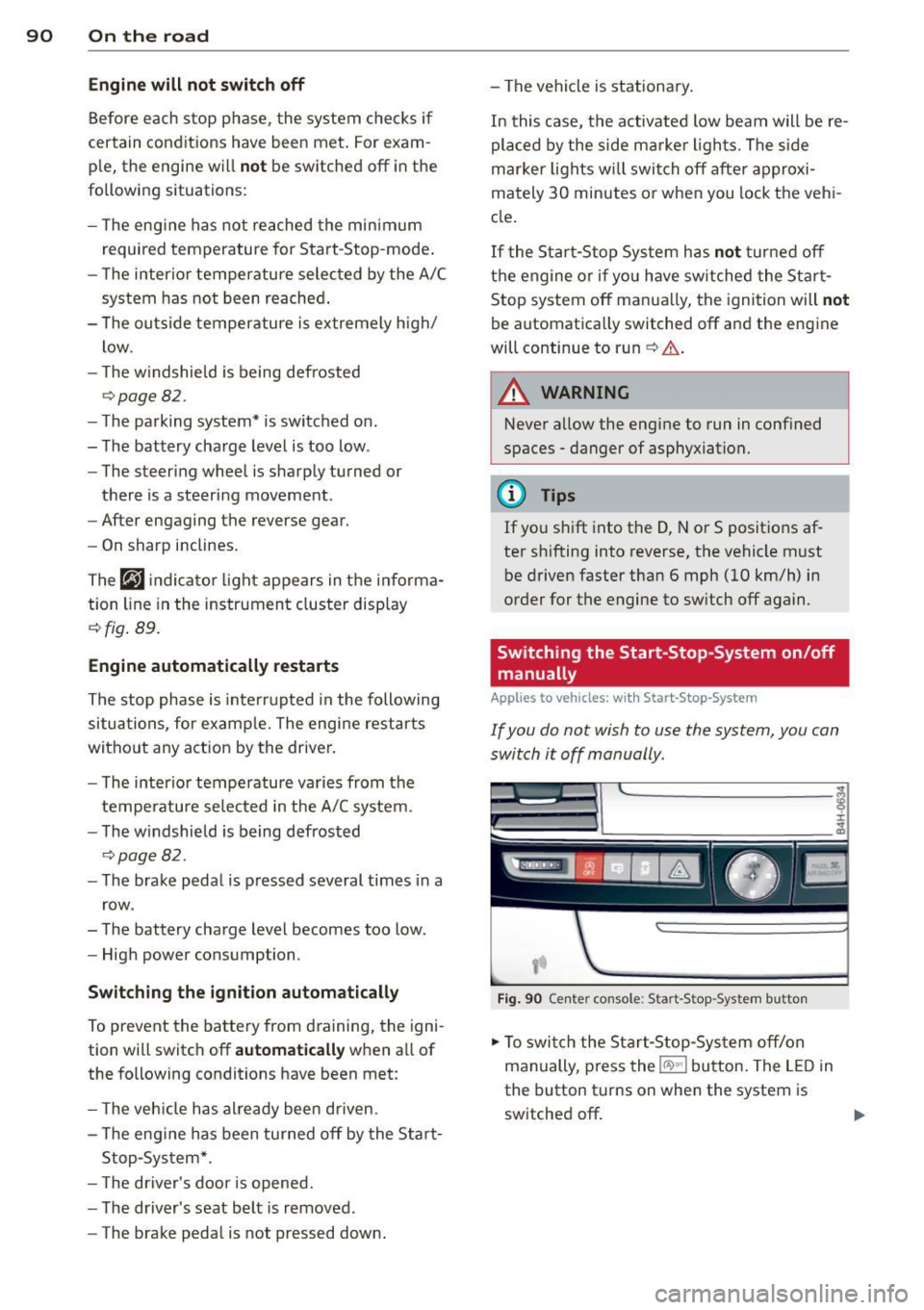
90 On the road
Engine will not swit ch off
Before each stop phase, the system checks i f
certain cond itions have been met. For exam
p le, the engine will
n ot be switched off in the
following situations:
- T he eng ine has not reached the minimum
required temperature for Start -Stop-mode .
- The inter io r temperature selec ted by the A/C
system has not been reached .
- T he outs ide temperature is extremely h igh/
low .
- T he w indshield is being defrosted
¢page 82.
-The parking system* is switched on.
- The battery charge level is too low .
- The steering wheel is sharply turned or
there is a steering movement.
- After engaging the reverse gear.
- On sharp inclines.
The
tiij indica to r light appears in the informa
tion line in the ins trument cluster disp lay
<=:>fig . 89 .
Engine automatically restarts
The stop phase is interrupted in the following
situations, for examp le. The engine restar ts
witho ut any act ion by the driver.
- T he interio r temperature varies from the
temperature selected in the A/C system .
- The w indshield is being defrosted
<=:> page 82.
- The brake pedal is pressed several times i n a
row .
- The battery charge level becomes too low .
- High power consumption.
Sw itching the ignition automatically
To prevent the battery from d raining, the igni
tion will switc h off
automat ically when a ll of
the following conditions have been met:
- T he veh icle has already been driven.
- T he eng ine has been tu rned off by the Star t-
Stop-System*.
- The driver's door is opened.
- The driver's seat belt is removed.
- The brake pedal is not pressed dow n. -
The vehicle is stationa ry .
In this case, the activated low beam will be re
placed by the side ma rke r lights. The s ide
marker lights w ill switch off after approxi
mately 30 minutes or when you lock the vehi
cle .
If the Star t-Stop System h as n ot turned off
the engine or if you have sw itched the Start
Stop system off man ua lly, the ignition will
not
be automatica lly switched off and the engine
will continue to ru n ¢ ,& .
A WARNING
=
Never allow the engine to run in confined
spaces -danger of asphyxiation.
(D Tips
If you shift into the D, Nor S posit ions af
ter sh ifting into reverse, the vehicle must
be driven faster tha n 6 mph (10 km/h) in
order for the engine to sw itch off again.
Switching the Start-Stop -System on/off
manually
App lies to vehicles: wi th Start-Stop -System
If you do not wish to use the system, you con
switch it off manually.
F ig . 90 Ce nter console: Start-Stop -System button
.,. To swi tch the Start-Stop-Sys tem off/on
manually, p ress the
l(A) ~·I button. The L ED in
the button turns on when the system is
switched off .
Page 203 of 314
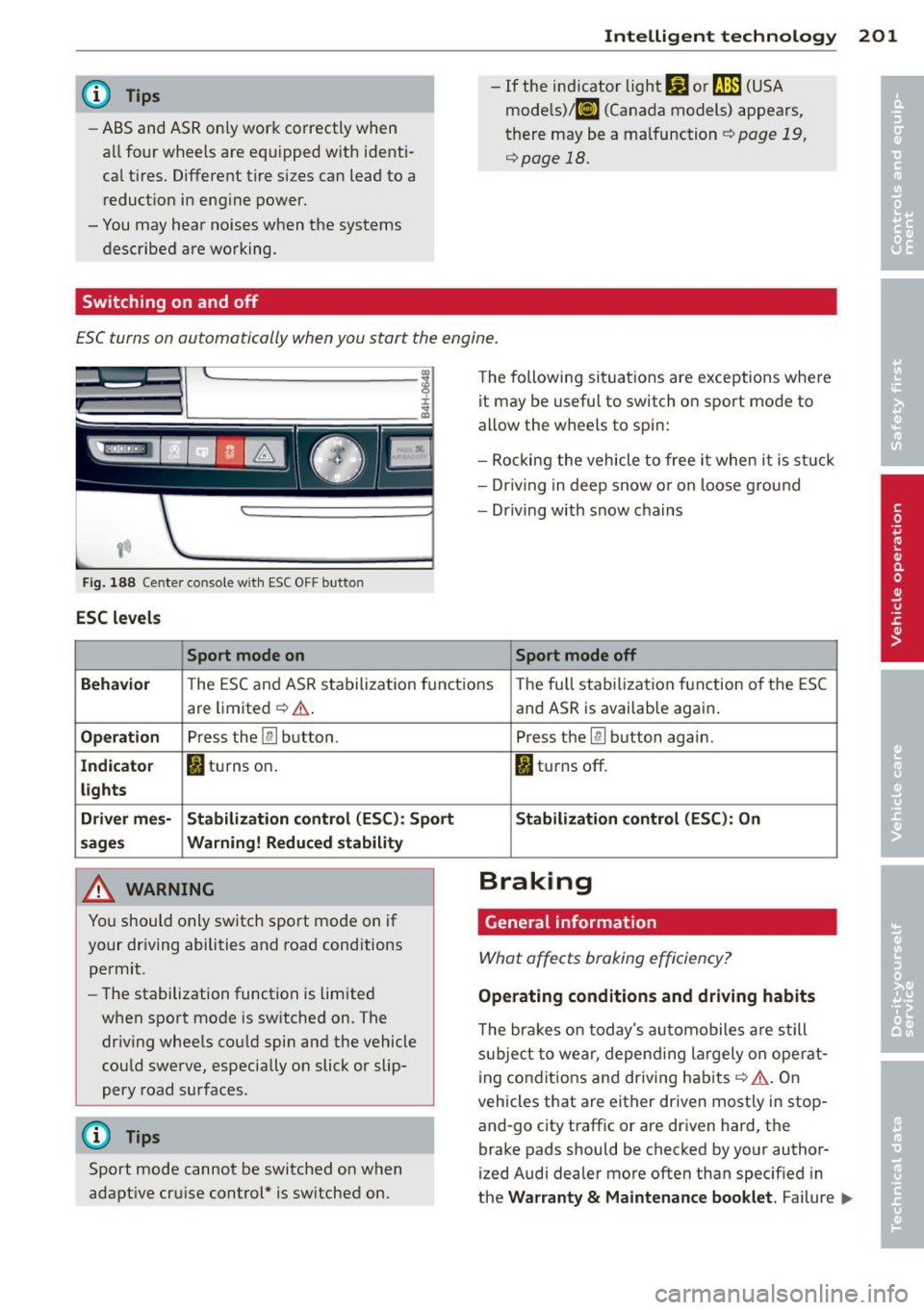
@ Tips
-ABS and AS R on ly wor k co rrectly when
a ll fo ur wheels are eq uipped w ith identi
ca l tires . Different tire s izes can lead to a
r educt io n in eng ine power.
- You may hear noises when the sys tems
desc ribed are working.
Switching on and off
Intelligent technology 201
- If the ind ica tor li ght DJ o r til1 (U SA
mo dels)/ [!] (Canada models) appea rs,
there may be a malfunc tion
r:::> page 19,
¢page 18.
ESC turns on automatically when you start the engine.
Fig . 188 Center co nsole with ESC O FF bu tton
ESC levels
Sport mode on
The following si tua tions are exceptions whe re
it may be usefu l to switch o n sport mo de to
allow the w heels to spi n:
- Rockin g the vehicle to free it when i t is st uck
- Dr iv ing in deep s now o r on loose g ro un d
- Dr iving with snow chains
Sport mode off
Behavior
T he E SC and AS R sta bilization f unct io ns The fu ll sta biliz ati on f uncti on o f the ES C
are limited¢ ,&.
Operation Press the [ru button .
Indicator II turns on .
lights
Driver mes· Stabilization control (ESC): Sport
sages Warning! Reduced stability
A WARNING
Yo u should o nly sw itch sport mo de on i f
your dr iv ing abili ties and road cond itions
permit.
- The stabilization function is limited
when sport mode is sw itched on. The
dr iv ing whee ls co uld spin and the vehicle
cou ld swe rve , especially on slick or slip
pery road surfaces.
(D Tips
Sport mode cannot be switched o n when
adapt ive cr uise c ontrol* is sw itched on.
-
and AS R is availab le again .
Press the
[ru button again .
II tur ns off.
Stabilization control (ESC): On
Braking
General information
What affects braking efficiency?
Operating conditions and driving habits
The bra ke s on today's au to m obiles a re s till
sub ject t o wear, depe nding la rgely o n ope rat
i ng con dit ions and d riving habits¢
A . On
vehicles that are either driven most ly in stop
and-go city traff ic or are driven hard , the
brake pads should be checked by your author
ized Audi dealer more often than specif ied in
t h e
Warranty & Maintenance booklet . Failure .,..
Page 204 of 314

202 Intellig ent technol ogy
to have your brake pads inspected can result
in reduced brake performance.
On steep slopes, yo u shou ld use the b rak ing
effect of the engine. Th is way, you prevent un
necessary wear on the brake system. If you
must use your brakes, do not hold the brakes
down continuously. P ump the brakes at inter
vals.
Operating nois e
Noises may occur when braking depending on
the speed, braking force and outside condi
tions such as temperature and humidity.
E ff ect of water and road salt
In certain situat ions, for example after driving
through water , in heavy ra in , after overn ight
condensation or after washing your car, the braking effect can be reduced by moisture or
ice on the brake rotors and brake pads. The
brakes must be dried first with a few careful
brake applications.
At higher speeds and with the windshield wip
ers turned on, the brake pads press against
the brake rotors for a short amount of time.
This occurs at regular intervals without the
driver noticing and provides for bet ter brake
response time under wet condit ions .
The effectiveness of the brakes can be reduced
when the vehicle is dr iven on a salt-covered
road and the brakes are not used . Likew ise,
you clean off accumulated salt coating from
brake discs and pads with a few caut ious ap
plications of the brake
9 .&, .
Cor ro sion
There may be a tendency for dirt to build up
on the brake pads and corrosion to form on
the discs if the car is not dr iven regularly or
only for short t rips with little use of the
b rakes .
If the brakes are not used frequently , or if cor
rosion has formed on the discs, it is advisable
to clean off the pads and discs by braking
firm ly a few times from a mode rately high
speed
9 .&, .
Faults in the brake syste m
If you shou ld notice a sudden increase in
brake pedal trave l, then one of the two brake
circuits may have fai led
9 & .
Low bra ke fluid lev el
Malfunctions can occu r in the bra ke system if
the b rake fluid level is too low. The brake flu id
level is monitored electro nica lly.
Brake lining we ar statu s
Brake lining wear may be checked by visual in
spect ion of the condition of the brake pads
th rough the open ings in the wheel. If neces
sary, the wheel may be removed for t his i n
spect ion
9 page 2 72, Changing a wheel.
A WARNING
- You shou ld perform braking maneuvers
for the purpose of cleaning the brake system only if road conditions permit.
Other road users must not be put at risk -
you may cause an accident!
- Before descending a steep grade, reduce
speed and sh ift transmission into a lower
gear or lower dr iving range. Do not ride
the brakes or hold the pedal down too
long or too often . This could cause the
b rakes to get hot and diminish braking
efficiency.
- Do not "ride the brakes" by rest ing your
foo t on the pedal when you do not intend
to brake. This may cause the brakes to
overheat, premature wear and increased
stopping distance.
- Unde r certain cl imatic and operat ing
conditions such as passing thro ugh wa
ter, driving in heavy rain or after washing
the vehicle, the effectiveness of the brakes can be reduced. In winter, ice can
accumu late on the brake pads, linings,
d iscs and drums. Carefully app ly brakes
for a test. Brakes will dry and ice coat ings will be cleaned off after a few care
fu l brake applicat ions.
- Driving for an extended period of t ime on
salt-covered roads without using your brakes can a lso affect bra king efficiency.
~
Page 205 of 314

Clean off accumulated salt coating from
brake discs and pads with a few careful
brake applicat ions .
-If you damage the front spoiler, or if you
install a different spoiler, be sure the air
flow to the front brakes is not obstruct ed . Otherwise the brake system could
overheat reducing the effectiveness of
the ent ire brake system.
- Failure of one brake c ircuit will impair
the braking capability resulting in an in
cr eased stopp ing distance. Avoid driv ing
the vehicle and have it towed to the near est Aud i dea ler or q ualified wor kshop .
- Never let the vehicle rol l to a stop w ith
t he engine shu t off.
- If the brake booster is not work ing, the
brake pedal must be pressed conside ra
bly harder to make up for the lac k of
booster assistance.
Brake booster
The brake booster adds extra braking power.
The brake booster works w ith vacuum pres
sure which is created only when the engine is
ru nning
9 ,&. .
,&. WARNING
-Never le t the vehicle ro ll to a stop w ith
t he engine shu t off.
- If the brake booster is not work ing, fo r
ex ample when towing your ve hicl e, or
because the b rake booste r has somehow
been damaged, the brake pedal must be
pressed considerab ly harder to make up
for the lack of booster assistance.
Servotronic - advanced
power steering system
-
The power steering systems use the power of
the running engine to allow precise steering
with little effort.
The advanced Servotronic power steering sys
tem senses the road speed and electron ically
ad ju sts powe r ass istance to provide comfor ta-
Int ellig ent technolog y 203
ble and safe steering response exactly match
ed to th e vehicle speed .
Power steer ing will not work if the engine is
off . As a result, the steering wheel will be h ard
to tu rn.
T he powe r stee ring fluid level is checked d ur
i ng t he sched uled maintena nce services.
(D Note
If there is an e lectronic malfunction, ser
votronic
will s till fu nction like a conven
tiona l powe r steering system, providing a
constant steering s upport force tha t is no
l onge r proportionate to the vehicle speed.
This is most noticeab le when t urni ng the
steering wheel at low speeds (for example
when parking), -more effort w ill be re
quired than usual.
- Be aware of the different than usual steering response and adjust your steer
ing force accordingly.
- Have the problem checked and set right by an Audi dealer as soon as possible.
(D Tips
-When the engine is running, never hold
the steering wheel turned all the way to
the right or to the left for longer than 15
seconds . The power steering pump will
overheat the hydraulic fluid if yo u keep
holding the stee ring wheel turned all the
way. This is likely to damage the power
steering sys tem.
- If the powe r stee ring system should fa il
entire ly, o r if t he engine is not runn ing
(for example, wh ile be ing towed), you
w ill still be able to steer the veh icle .
However,
considerably more effort will
be required to do so .
- If the powe r steering system sho uld
have a leak, or is not functioning proper
ly, contact your author ized Audi dealer
immediately.
- The power steering system req uires a
specially formu lated hydraulic fluid. The
power steering fluid reservoir is located
in the engine compartment
9 page 233. IJJ,,
•
•
Page 211 of 314
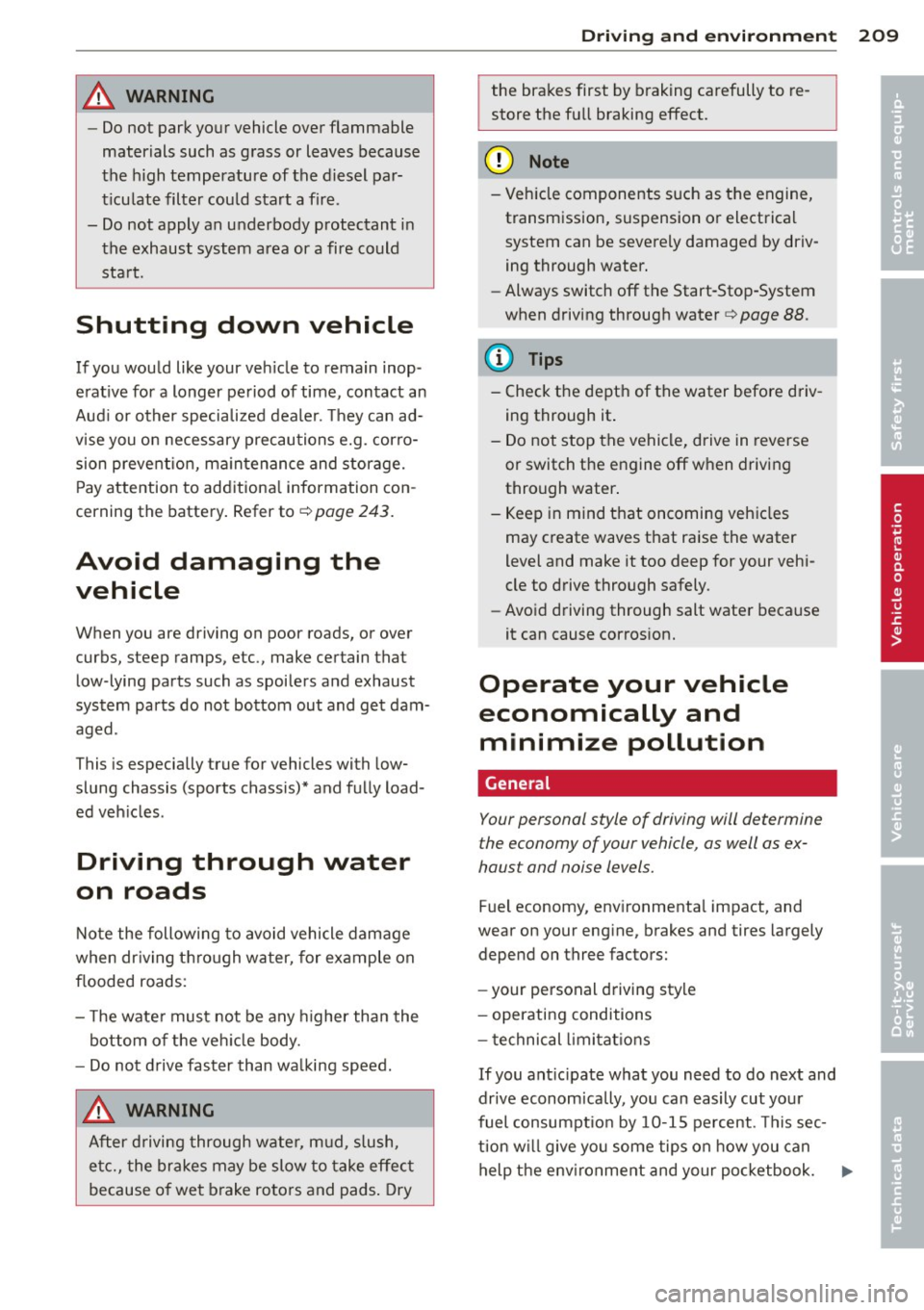
A WARNING ,~
- Do not park your vehicle over flammable
materials such as grass or leaves because
the high temperature of the diesel par
t icu late filter cou ld start a fire .
- Do not apply an underbody protectant in the exhaust system area or a fire could start .
Shutting down vehicle
If you would like your veh icle to remain inop
erat ive for a longer period of time, contact an
Aud i or other specia lized dealer. They can ad
vise you on necessary precautions e.g . corro
sion prevention, ma intenance and storage.
Pay attention to additiona l information con
cerning the battery. Refer to~
page 243.
Avoid damaging the
vehicle
When you a re driving on poor roads, or over
curbs, steep ramps, etc., make certain that low-lying parts such as spoilers and exhaust
system parts do not bottom out and get dam
aged.
This is especially true for vehicles with low
slung chassis (sports chassis)* and fully load
ed vehicles.
Driving through water
on roads
Note the following to avoid vehicle damage
when driving through water, for example on
flooded roads :
- The water must not be any higher than the
bottom of the veh icle body.
- Do not drive faster than wa lking speed.
A WARNING
After driving through water, mud, slush,
etc., the brakes may be slow to take effect
because of wet brake rotors and pads. Dry
-
Drivin g and environment 209
the brakes first by braking carefully to re
store the full braking effect.
(D Note
- Vehicle components such as the engine,
transmission, suspension or electrical
system can be severely damaged by driv
ing through water.
- Always switch off the Start-Stop-System
when driving through water~
page 88.
(D Tips
-Check the depth of the water before driv
ing through it .
- Do not stop the vehicle, drive in reverse
or switch the engine off when driving
through water.
- Keep in mind that oncoming vehicles may create waves that raise the water
level and make it too deep for your vehi
cle to drive through safely .
- Avoid driving through salt water because
it can cause corrosion.
Operate your vehicle
economically and minimize pollution
General
Your personal style of driving will determine
t he economy of your vehicle , as well as ex
haus t and noise levels.
Fuel economy, environmental impact, and
wear on your engine, brakes and tires largely
depend on three factors:
- your personal driving style
- operating conditions
- technical limitations
If you ant icipate what you need to do next and
drive econom ically, you can easily cut your
fuel consumpt ion by 10-15 percent . Th is sec
tion w ill give you some tips on how you can
help the env ironment and your pocketbook. •
•
Page 212 of 314

210 Driving and environment
The consumption estimates as published
by ENVIRONMENTAL PROTECTION AGENCY
(EPA) and Transport Canada may not corre
spond to your actual consumption on the
road, which will vary depending upon vehi
cle load and speed, road and weather con
ditions, trip length, etc.
Drive smoothly and keep a lookout
ahead
Vehicles use the most fuel when they are ac
celerating.
• Avoid unnecessary accelerating and braking.
Vehicles use the mo st fuel when they are ac
celerating. If you anticipate what is going to happen next, you will need to brake less and,
thus , accelerate less. Let the vehicle coast
whenever possible -for example when you see
that the next traffic light is red.
Avoid full throttle
Driving at moderate speeds saves fuel and
improves your mileage.
• Try and keep well below your car's maximum
speed .
Accelerating gently reduces fuel consump
tion, engine wear, and does not disturb the
environment .
Fuel consumption, exhaust emissions and en
gine noise increase disproportionately at high
speeds. If you drive at approximately three
quarters of top speed, fuel consumption will
be reduced by one half. Never drive faster
than the posted speed limit and weather con
ditions permit.
Reducing unnecessary idling
Even when your car is just idling it burns up
fuel.
• Shut the engine off when you are not driving
the vehicle. •
Do not warm up the vehicle by letting the
engine run at idle.
The idling phase is automatically reduced for
vehicles with the Start/Stop system. It is effi
cient to switch off the engine in vehicles with
out the Start-Stop-System when stopped at
railroad crossings and long red lights. Turning
the engine off for jus t 30-40 seconds saves
more fuel than is burned by starting the en-
. . gme again.
It takes a long time for the engine to warm up
fully when it is running at idle. However, wear
and noxious emissions are especially high
when the engine is warming up . So you should
drive away as soon as you start the engine and
avoid running at high rpms while the engine is
still warming up.
W Note
Do not leave engine idling unattended af
ter starting . If warning lights should come
on to indicate improper operation, they
would go unheeded. Extended idling also
produces heat, which could result in over
heating or other damage to the vehicle or
other property.
Regular maintenance
A badly tuned engine unnecessarily wastes a lot of fuel.
• Have your vehicle serviced at regular inter-
vals.
By having your vehicle regularly serviced by an
Audi dealer helps to ensure that it runs prop
erly and economically. The condition of your
vehicle not only affects its safety and ability to
hold its value, it also affects
fuel consump
tion.
Check your oil each time you
fill your tank.
The amount of oil used is related to engine
load and speed.
It is normal for the oil consumption of a new
engine to reach its lowest value after a certain
mileage has been driven . ..,.
Page 215 of 314
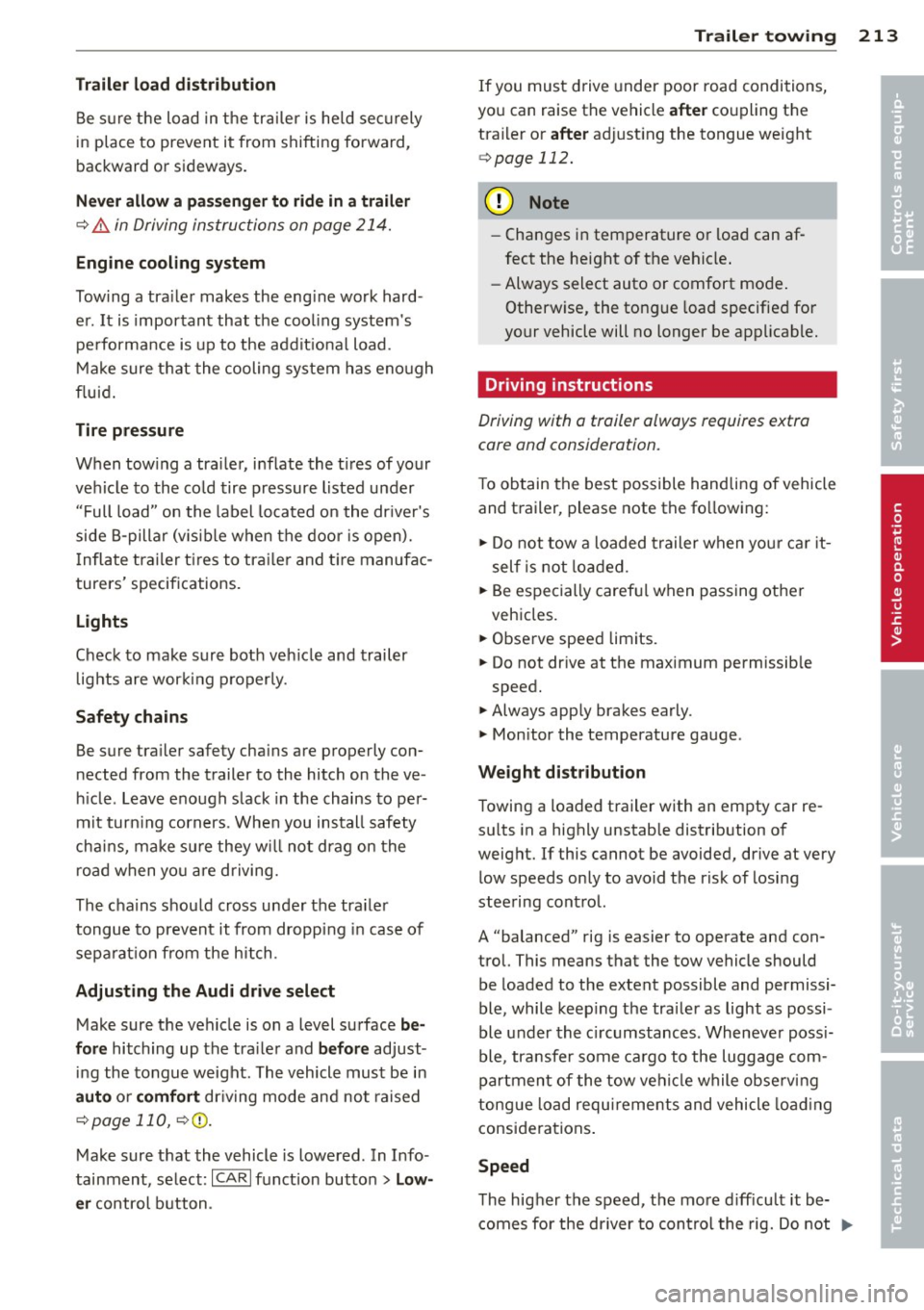
Trailer load distribution Be sure the load in the trailer is held securely
in place to prevent it from shifting forward,
backward or sideways.
Never allow a passenger to ride in a trailer
¢ .&. in Driving instructions on page 214.
Engine cooling system
Towing a trailer makes the engine work hard
er . It is important that the cooling system's
performance is up to the additional load .
Make sure that the cooling system has enough
fluid.
Tire pressure
When towing a trailer, inflate the tires of your
vehicle to the cold tire pressure listed under
"Full load" on the label located on the driver's
side B-pillar (visible when the door is open).
Inflate trailer tires to trailer and tire manufac
turers' specifications.
Lights
Check to make sure both vehicle and trailer
lights are working properly.
Safety chains Be sure trailer safety chains are properly con
nected from the trailer to the hitch on the ve
hicle . Leave enough slack in the chains to per
mit turning corners . When you install safety
chains, make sure they will not drag on the
road when you are driving.
The chains should cross under the trailer
tongue to prevent it from dropping in case of
separation from the hitch .
Adjusting the Audi drive select Make sure the vehicle is on a level surface
be
fore
hitching up the trailer and before adjust
ing the tongue weight. The vehicle must be in
auto or comfort driving mode and not raised
¢page 110, ~CD .
Make sure that the vehicle is lowered. In Info
tainment, select:
ICARI function button> low
er control button .
Trailer towing 213
If you must drive under poor road conditions,
you can raise the vehicle
after coupling the
trailer or
after adjusting the tongue weight
¢ page 112.
@ Note
- Changes in temperature or load can af
fect the height of the vehicle.
- Always select auto or comfort mode.
Otherwise, the tongue load specified for
your vehicle will no longer be applicable.
Driving instructions
Driving with a trailer always requires extra
core and consideration.
To obtain the best possible handling of vehicle
and trailer, please note the following:
.,. Do not tow a loaded trailer when your car it
self is not loaded .
.,. Be especially careful when passing other
vehicles.
.,. Observe speed limits.
.,. Do not drive at the maximum permissible
speed .
.,. Always apply brakes early .
.,. Monitor the temperature gauge.
Weight distribution
Towing a loaded trailer with an empty car re
sults in a highly unstable distribution of
weight. If this cannot be avoided, drive at very
low speeds only to avoid the risk of losing
steering control.
A "balanced" rig is easier to operate and con
trol. This means that the tow vehicle should be loaded to the extent possible and permissi
ble, while keeping the trailer as light as possi
ble under the circumstances . Whenever possi
ble , transfer some cargo to the luggage com
partment of the tow vehicle while observing
tongue load requirements and vehicle loading
considerations.
Speed
The higher the speed, the more difficult it be
comes for the driver to control the rig. Do not .,.
•
•